
* By the end of World War II, the US was experimenting with jet fighter aircraft -- which inevitably led to experiments with jet bomber aircraft. The first American jet bomber was the Douglas "XB-43", derived from the piston-powered "XB-42". That led to a development of a trio of experimental jet bombers, known as the "Class of '45", including the North American "XB-45", Convair "XB-46", and Martin "XB-48", with Martin also developing an attack aircraft, the "XB-51". None of these aircraft entered production except for the XB-45, which went into operational service as the "B-45 Tornado". This document provides a history and description of America's first jet bombers.
* During World War II, the Allies became increasingly interested in turbojet-powered aircraft. The US Army Air Forces (USAAF) first interest was in jet fighters, but there was also interest in jet bombers. However, the USAAF's first jet bomber actually started life as a prop aircraft, the Douglas "XB-42".
The XB-42 began life as a company-funded venture, designed by a team under Douglas engineer Ed Burton to serve as a fast, long-range medium bomber. The company submitted the concept to the USAAF in May 1943. The USAAF liked the idea, and issued Douglas a contract on 25 June 1943 for delivery of a static test airframe and two flight prototypes. The type was originally designated "XA-42" to indicate that it was an attack type, but the designation was changed during development.
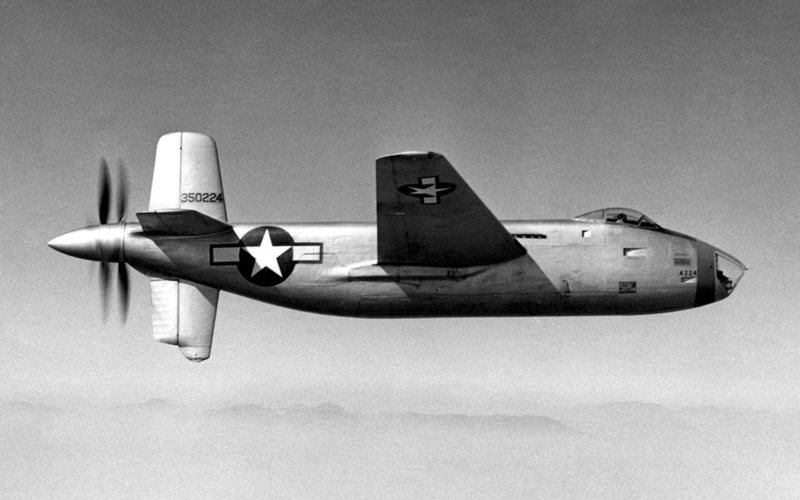
The first XB-42 prototype performed its initial flight on 6 May 1944. The bomber's configuration was unusual and imaginative, most significantly featuring twin Allison V-1710-125 vee-12 engines with 990 kW (1,325 HP) take-off power each, driving via a shaft and a gearing system contra-rotating three-bladed pusher propellers at the tail of the aircraft; each engine drove a separate propeller. The prop assembly could be blown off if the crew had to bail out. The tail was of cruciform configuration to protect the propellers on take-off. The contra-rotating pusher propellers led Douglas to name the aircraft the "Mixmaster", after a popular blender of the time.
Other features of the machine were:
It was to be armed with two fixed forward-firing 12.7-millimeter (0.50-caliber) Browning machine guns in the nose, plus four rearward-firing Brownings, mounted in pairs in the trailing edge of each wing, directed by remote control. The rear-firing guns were directed by the copilot using a sight at the rear of the cockpit, and were mainly intended for rear defense as the aircraft primarily relied on speed for protection. There were concepts for a version that would have 16 machines guns, or two 37-millimeter cannon and two machine guns, or a 75-millimeter cannon and two machine guns -- but they didn't happen. There was also thought of a reconnaissance version, but that didn't happen either.
Internal bombload was 3,630 kilograms (8,000 pounds). Four fuel tanks with a capacity of 1,040 liters (275 US gallons) could be plugged into the bomb bay for ferry flights, while a 1,135-liter (300 US gallon) tank could be carried under each wing.
___________________________________________________________________
DOUGLAS XB-42:
___________________________________________________________________
wingspan:
21.49 meters (70 feet 6 inches)
length:
16.36 meters (53 feet 8 inches)
height:
5.74 meters (18 feet 10 inches)
empty weight:
9,475 kilograms (20,900 pounds)
loaded weight:
16,200 kilograms (35,700 pounds)
max speed at altitude:
660 KPH (410 MPH / 355 KT)
service ceiling:
8,960 meters (29,400 feet)
range:
2,900 kilometers (1,800 MI / 1,565 NMI)
___________________________________________________________________
The second prototype performed its first flight on 1 August 1944; it was similar to the first prototype, but had uprated Allison engines with 1,250 kW (1,645 HP) take-off power each. It was quickly modified to replace the twin fighter-style canopies with a single cockpit providing side-by-side accommodations for the pilot and copilot. The dual cockpit scheme had provided excellent visibility, but restricted communications between aircrew and was disliked. In early December 1944, the second prototype performed a cross-country flight from California to Washington DC at an average speed of 698 KPH (433.6 MPH). However, this aircraft was lost in a crash on 16 December 1944, the crew escaping safely.
By that time, the USAAF had decided not to produce the XB-42 anyway. Although it was an excellent aircraft, with performance, range, and payload up to or exceeding design specifications, the Air Force was looking forward towards jet bombers. The first XB-42 was then converted to hybrid power, being fitted with uprated Allison V-1710-133 engines, with 1,025 kW (1,375 HP) each, and a Westinghouse 19XB-2A turbojet with kilograms 7.12 kN (725 kgp / 1,600 lbf) thrust mounted under each wing, and redesignated "XB-42A". It was flown as an evaluation machine up into 1949, and is now in the possession of the Smithsonian National Air & Space Museum (NASM).
Douglas also considered an airliner version of the B-42, same general configuration but with an airliner fuselage, designating it the "DC-8". It didn't happen either, but the "DC-8" designation was passed on to Douglas's first production jetliner.
* The USAAF decided to acquire their first pure-jet bomber by the simple measure of adapting the XB-42 design. Studies were conducted in the fall of 1943 that showed it was practical, and on 31 March 1944 Douglas was awarded a contract by the USAAF for two prototypes of the new jet bomber, to be designated "XB-43". After a series of delays, largely due to engine development problems, the first XB-43, which was a rebuild of the XB-42 static test example, performed its first flight on 17 May 1946.
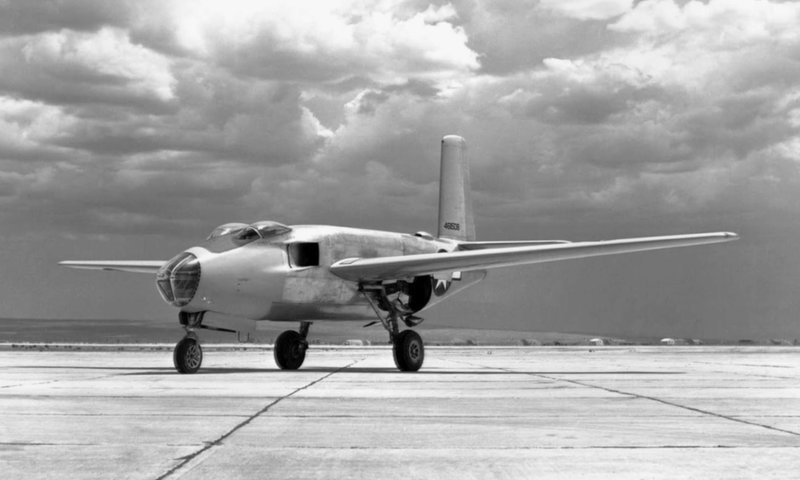
The XB-43 very much resembled the XB-42, with the original "bug-eye" cockpits, but with the addition of flush jet intakes in the upper fuselage behind the cockpits and twin exhausts in the tail. It was powered by twin General Electric TG-180 turbojets -- later redesignated the J35, which would power the North American F-86 Sabre. The ventral fin of the XB-42's cruciform tail was deleted, there being no worries about prop strikes, with the XB-43's tailfin raised to compensate.
___________________________________________________________________
DOUGLAS XB-43:
___________________________________________________________________
wingspan:
21.69 meters (71 feet 2 inches)
length:
15.6 meters (51 feet 2 inches)
height:
7.39 meters (24 feet 3 inches)
empty weight:
9,875 kilograms (21,775 pounds)
loaded weight:
17,930 kilograms (39,530 pounds)
max speed:
830 KPH (515 MPH / 445 KT)
service ceiling:
11,735 meters (38,500 feet)
range:
1,770 kilometers (1,100 MI / 955 NMI)
___________________________________________________________________
Two versions were proposed: a medium bomber with a warload of 2,720 kilograms (6,000 pounds); and an attack version with 16 fixed forward-firing 12.7-millimeter (0.50-caliber) Browning M2 machine guns and provision for underwing stores, such as 35 12.7-centimeter (5-inch) high-velocity aircraft rockets (HVAR). Both would be fitted with a remotely controlled tail turret with twin 12.7-millimeter Brownings.
Performance of the XB-43 was generally to specification -- though like many early jet aircraft, it was underpowered. However, the USAAF wanted a larger jet bomber by that time, and so the XB-43 effort was reduced to an experimental program. The first prototype was grounded after an accident in early 1951. The second prototype, designated "YB-43", was completed in May 1947. It was used as an engine testbed until it was retired in late 1953. The first prototype was cannibalized to keep the second flying, and the second is now in the possession of NASM. Some sources claim the YB-43 was eventually fitted with the unified canopy, but images of the NASM artifact show it with the bug-eye cockpit arrangement.
BACK_TO_TOP* Late in World War II, the USAAF initiated a competition for the development of a heavy jet bomber, with a spec issued in April 1944 for a machine with a 1,600-kilometer (1,000-mile) operational radius, a maximum speed of 800 KPH (500 MPH), a ceiling of 12,200 meters (40,000 feet), and a maximum bombload of 9,975 kilograms (22,000 pounds). Typical bombload was more expected to be 3,630 kilograms (8,000 pounds). The bomber was to be powered by the new General Electric (GE) TG-180 axial-flow engine (later built as the GE J35) or its more powerful derivative, the TG-190 (later built as the GE J47).
Four manufacturers built prototypes for the competitive flyoff evaluation: North American's "XB-45", Convair's "XB-46", Boeing's "XB-47", and Martin's "XB-48". The XB-47 was the only one of the four that had swept wings and was clearly a generation ahead of the other three; it was selected as the preferred solution, but it would take time to get into service and its advanced nature made it technically risky. As a result, the USAAF ordered the XB-45 into production as an interim solution.
The XB-45 is discussed later. Three Convair XB-46s were to be built, but only one was completed, the funds being diverted from the other two. The XB-46 was considered, along with the XB-45, as an interim bomber until a more advanced bomber went into service. The USAAF decided not to proceed with the XB-46 even before it flew, saying its greater weight and low internal volume made it inferior to the XB-45, but decided to let the single prototype fly for test purposes.
The XB-46, known to the company as the "Model 109", was a sleek if conservative design, of all-metal construction and with a cigar-like fuselage; high-mounted straight wings; a straight tail assembly, the tailfin having a prominent forward fillet; tricycle landing gear, all gear assemblies with single wheels, the nose gear retracting backward, the main gear retracting forward into the engine nacelles; and four GE TG-180 / J35 turbojets, with two in a pod under each wing. In maturity, the aircraft would have J35-A-3 engines with 17.8 kN (1,815 kgp / 4,000 lbf) thrust each.
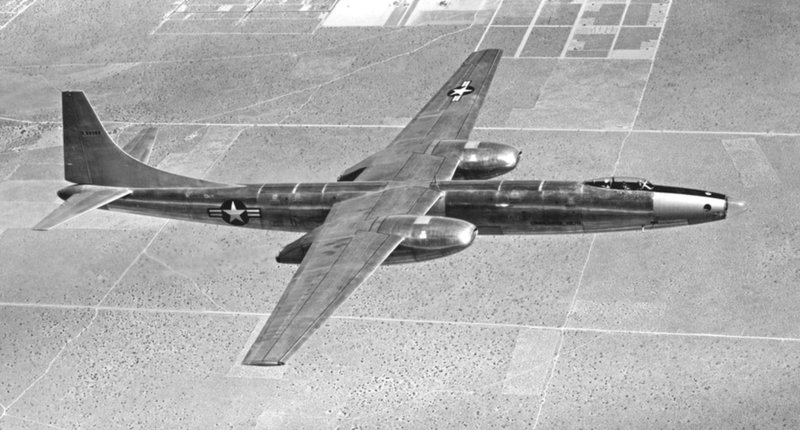
Each wing had a long Fowler flap, a small aileron, and a long spoiler on top for roll control. Tail surfaces were conventional, with rudder and elevators. Actuation of flight surfaces, as well as the landing gear, was all pneumatic. The three crew were in a pressurized cockpit, with the pilot and copilot in tandem under a bubble canopy, and the bombardier in the glazed nose, with a bombing radar under the nose. In principle, it was to have a remote-controlled tail turret with a radar sighting system, operated by the copilot with his seat reversed -- but it doesn't appear the tail turret was ever fitted, since there was no thought of putting the XB-46 into operational service.
___________________________________________________________________
CONVAIR XB-46:
___________________________________________________________________
wingspan:
34.44 meters (113 feet)
wing area:
120 sq_meters (1,285 sq_feet)
length:
32.23 meters (105 feet 9 inches)
height:
8.51 meters (27 feet 11 inches)
empty weight:
21,780 kilograms (48,020 pounds)
max take-off weight:
41,275 kilograms (91,400 pounds)
max speed at altitude:
875 KPH (545 MPH / 475 KT)
service ceiling:
12,200 meters (40,000 feet)
range:
4,620 kilometers (2,870 MI / 2,490 NMI)
___________________________________________________________________
The single XB-46 performed its initial flight on 2 April 1947, with E.D. "Sam" Shannon and Bill Martin at the controls. Trials were performed on the aircraft into 1950, with the aircraft being scrapped in 1952. The front fuselage may have survived.
* The Martin XB-48 followed much the same development track from 1944, with two prototypes being built -- the first flying on 22 June 1947, the second on 16 October 1948. Like the XB-46, it was a conservative design -- less sleek and heavier, with a high-mounted wing and three TG-180 turbojets in an aerodynamic clustered nacelle under each wing. The first prototype was powered by the J47-GE-7 variant, with 14.6 kgp (1,490 kgp / 3,280 lbf) thrust each; the second was powered by the J47-GE-9, with 23.1 kN (2,360 kgp / 5,200 lbf) thrust each.
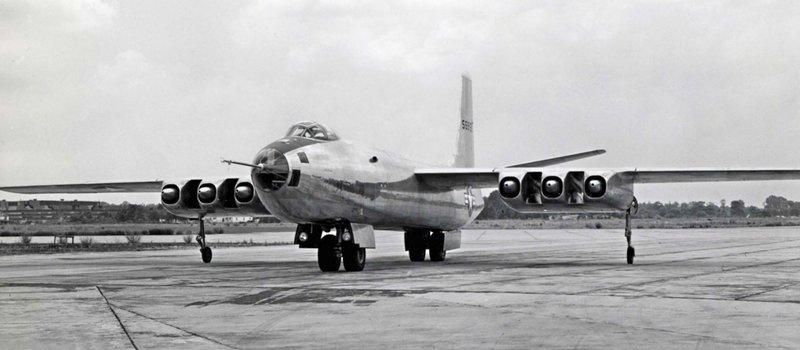
The pilot and copilot sat in tandem under a bubble-style canopy, with the navigator-bombardier sitting in the glazed nose. The XB-48 had bicycle-type retractable landing gear, with twin wheels on the fore and aft fuselage main gears, and outriggers outside of the engine pods. It was to have a tail turret with twin 12.7-millimeter Brownings, directed by AN/APG-27 radar, but it doesn't appear guns were ever fitted.
___________________________________________________________________
MARTIN XB-48:
___________________________________________________________________
wingspan:
33.02 meters (108 feet 4 inches)
wing area:
123.5 sq_meters (1,330 sq_feet)
length:
26.14 meters (85 feet 9 inches)
height:
8.08 meters (26 feet 6 inches)
empty weight:
26,535 kilograms (58,500 pounds)
operating weight:
42,000 kilograms (92,600 pounds)
max speed at altitude:
840 KPH (525 MPH / 455 KT)
service ceiling:
12,010 meters (39,400 feet)
range:
2,900 kilometers (1,800 MI / 1,565 NMI)
___________________________________________________________________
Initial trials were plagued by the immaturity of the J47 engines, with the first XB-48 prototype going through at least 14 engines during its first 44 flights. By the spring of 1948, to no great surprise the Boeing XB-47 had far better performance, and in fact the XB-48 wasn't meeting its design specs. The program was dead before the first flight of the second prototype. Martin proposed modifying the second prototype, replacing the J47 turbojets with four XT40 turboprops, but the Air Force wasn't interested.
The XB-48s kept on flying for test and trials, though the first prototype was cannibalized for spares in 1949 to keep the second prototype flying. The second prototype was flown to Aberdeen Proving Grounds in Maryland in 1951, to be tested to destruction. The remains of both aircraft ended up on the scrapheap.
BACK_TO_TOP* The North American B-45 Tornado was, as already described, the only one of the "also-rans" in the "Class of 45" to go to production. Three XB-45 prototypes had been ordered in 1945 for evaluation. The initial XB-45 prototype made its first flight on 17 March 1947. One of the prototypes was lost in a fatal crash, one was written off after a landing accident, with the surviving prototype being retired in 1950 and eventually scrapped. Even before the first flight of a prototype, an order for what would end up being 96 production B-45As had been placed, with initial deliveries to the US Air Force (as the USAAF had become in the meantime) in 1948.
The B-45A provides a baseline for the series. The Tornado was a shoulder-winged aircraft with straight wings and conventional tail surfaces, the tailplane having a noticeable dihedral -- it seems to keep it out of the jet exhaust. Flight control surface arrangement was conventional -- single-slotted flaps, ailerons, rudder, elevators, all with hydraulic boost. It featured tricycle landing gear and a greenhouse-style canopy, plus a glazed nose. Electrothermal de-icing was used.
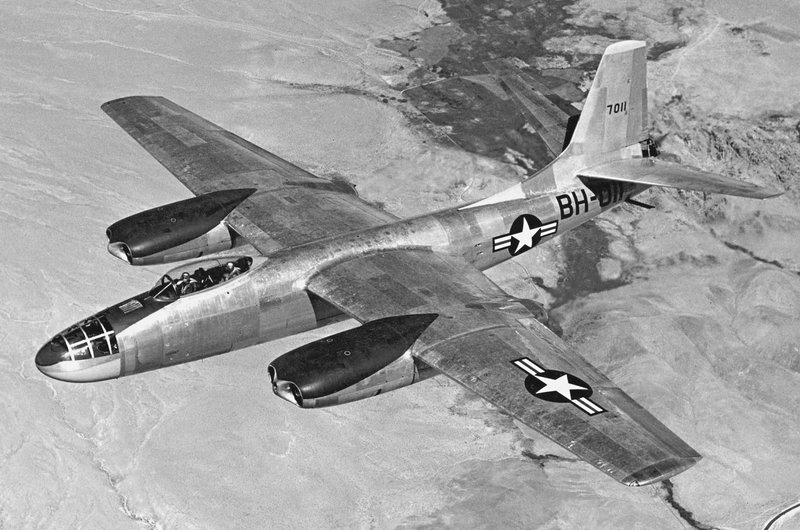
The B-45A was powered by General Electric J47-GE-9 engines, with 23.1 kN (2,360 kgp / 5,200 lbf) thrust each -- the XB-45s had been powered by J35-A-4 engines, with 14.8 kN (1,815 kgp / 4,000 lbf) thrust each, while the first 22 B-45As had J35-A-11 engines, the power ratings not being clear. The engines were mounted in pairs in a pod on the leading edge of each wing. A rocket-assisted take-off (RATO) booster or a ferry tank could be attached under each engine pod.
There were four crew, including pilot, copilot, bombardier / navigator, and tail gunner. The pilot and copilot sat under a bubble canopy, and had ejection seats. The other two crew got out through escape doors featuring airblast shields. The cabin was pressurized; the prototypes didn't have cabin pressurization, at least initially. The B-45A featured an autopilot and bombing-navigation radar.
The high speed (for the time) led the USAAF to conclude that the only required defensive armament was a tail stinger with twin 12.7-millimeter Browning machine guns. The original plan for the XB-45 envisioned the tail stinger as being remotely operated by the co-pilot using radar sighting, meaning no need for a tail gunner, but it couldn't be made to work right.
The first 22 B-45As, with the J35 engines, were not seen as suitable for service, and were used for evaluation, training, and test. The B-45A went into formal service with the 47th Bomb Group in November 1948, the last being delivered in 1950. The B-45A wasn't really acceptable for service at the outset, suffering from big problems with aircraft reliability, the engines being a particular trial.
The worst problems were fixed, with the fleet upgraded in the early 1950s under Project BACKBREAKER to carry nuclear bombs, along with improved avionics plus a chaff dispenser, fitted behind the bomb bay. Depending on the size of the bomb, an auxiliary fuel tank could be fitted in the rear of the bomb bay. The original tail turret had a cramped field of view, so the BACKBREAKER machines had a "bubble dome" facing to the rear with an improved sighting system. These aircraft mostly flew out of RAF Sculthorpe in Britain, and Barksdale AFB in Louisiana. They were replaced by the B-47 and removed from first-line service by 1958.
___________________________________________________________________
NORTH AMERICAN B-45 TORNADO:
___________________________________________________________________
wingspan:
27.13 meters (89 feet)
wing area:
109.2 sq_meters (1,175 sq_feet)
length:
22.96 meters (75 feet 4 inches)
height:
7.67 meters (25 feet 2 inches)
empty weight:
20,725 kilograms (45,695 pounds)
operating weight:
36,930 kilograms (81,420 pounds)
max take-off weight:
41,630 kilograms (91,755 pounds)
max speed at altitude:
910 KPH (565 MPH / 490 KT)
cruise speed;
585 KPH (365 MPH / 315 KT)
service ceiling:
14,000 meters (46,000 feet)
operational range:
1,920 kilometers (1,190 MI / 1,035 NMI)
ferry range:
3,490 kilometers (2,170 MI / 1,890 NMI)
___________________________________________________________________
A "B-45B" with new radar and fire control systems was considered but not built, and so the next version was the "B-45C", a tactical support variant. It featured:
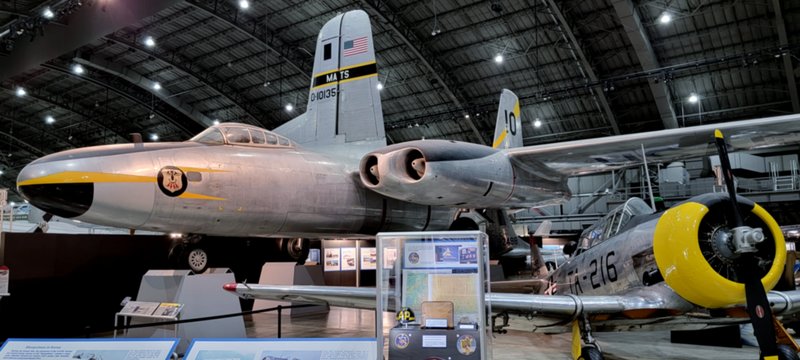
Initial flight of the B-45C was on 3 May 1949. Although 60 were ordered, only ten were actually built, the rest being canceled to free up funds for building more B-36 bombers. However, North American did complete 33 "RB-45C" reconnaissance-bomber machines, with the airframe of the B-45C but with a fit of seven cameras:
The camera operator in the nose had a downward-looking viewfinder system. Some sources give more cameras, for example four more vertical cameras in the nose, with illustrations suggesting gear for mounting oblique cameras in the rear fuselage, in place of the trimetrogon array; the number of cameras was obviously flexible. The bomb bay was used to accommodate additional fuel tanks and photoflash flares. Initial flight of the RB-45C was in April 1950, with final deliveries in October 1951.
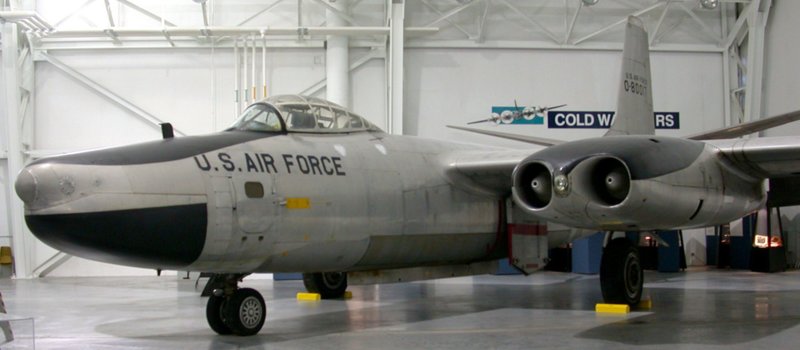
The RB-45Cs had something of an exciting service career. They flew combat reconnaissance missions over North Korea early on in the conflict there, one being shot down by Russian-piloted MiG-15 fighters on 5 December 1950, the four crew being lost. RB-45Cs did conduct more missions over North Korea, being provided with fighter escort, but within a year the RB-45Cs were switched to night missions. They didn't prove all that satisfactory in that role either, still being vulnerable to interception. However, lacking better assets they soldiered on, and in fact performed reconnaissance missions into Manchuria and the Soviet Far East. The RB-45C also flew reconnaissance missions over East Bloc countries from Britain, with some of the missions flown by British Royal Air Force (RAF) crews, the aircraft being given dubious RAF markings.
There was apparently variation in tail turret fit, with tail guns removed from some RB-45Cs; ground crews fitted dummy guns and, at least in one case, improvised a fixed gun arrangement to discourage pursuers. Three RB-45Cs were stripped of reconnaissance kit and converted to a BACKBREAKER-style configuration to carry nuclear munitions, clearly as a stopgap.
The RB-45Cs were replaced by RB-47s. After withdrawal from first-line service, 14 B-45As were converted to "TB-45A" target tugs, while a few others became "DB-45A" or "DB-45C" missile directors, and a few were used for engine trials. They lingered into the early 1970s. A few B-45s survive as museum displays.
BACK_TO_TOP* As a footnote to the "Class of 45", the Martin Company developed another first-generation American jet bomber, the "XB-51", intended for the attack role. It started life as a 1944 USAAF requirement for an experimental light bomber aircraft, with Martin coming back with a series of proposals, and the USAAF refining the requirement in parallel. In May 1946, the USAAF issued a contract for two Martin "XB-51" prototypes. After further changes in design, the first prototype performed its initial flight on 28 October 1949, followed by the second on 17 April 1950.
By the standards of the time, the XB-51 was breathtakingly innovative, pure science fiction. It was an all-metal aircraft with bicycle landing gear like that of the XB-48, a low swept wing, a swept tee tail, and three TG-190 engines -- in operation, the J47-GE-13 variant, with 23.1 kN (2,360 kgp / 5,200 lbf) each. Two of the engines were in "cheek" positions under the forward fuselage, while the third was in the tail, with an intake in front of the tailfin. They had water-methanol injection for boost thrust on take-off; the XB-51 could also be fitted with twin RATO boosters on each side of the rear fuselage for take-offs, each booster providing 4.45 kN (450 kgp / 1,000 lbf) thrust.
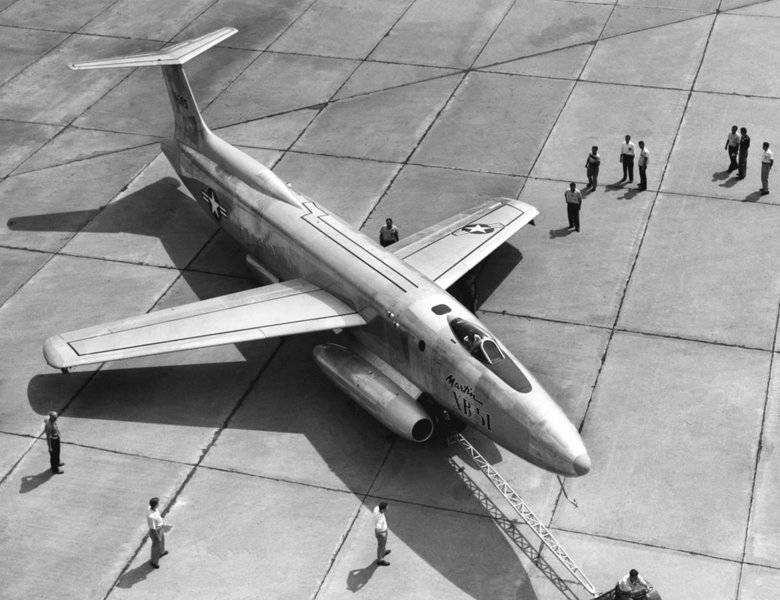
The wings being thin, all fuel tankage was in the fuselage, consisting of three tanks with a total capacity of 10,730 liters (2,835 US gallons). Two ferry tanks could be plugged into the bomb bay to provide 2,650 liters (700 US gallons) more fuel.
The wings had a sweepback of 35 degrees, six degrees of anhedral droop and, unusually, variable incidence. They had one-piece slotted flaps on the back of the wing, almost out to the wingtips, plus semi-automatic slats over about two-thirds of the front of the wing. There was a big one-piece spoiler in front of each flap, the spoilers being used for roll control and presumably as lift dumpers, along with small "trimmer" ailerons near the wingtips that were, apparently, partly intended to provide feedback. The tail assembly had elevators and rudder; a bullet fairing between the tailfin and the tailplane was added to the first prototype after early flights, the second prototype flying with the bullet fairing. The XB-51 also featured trim tabs.
Each of the main gear assemblies had two wheels; small outrigger gear extended from the wingtips to keep the aircraft from tipping. The front wheel assembly was steerable. The landing gear had antiskid braking; the XB-51 also had a brake chute to reduce landing roll. Control surfaces and the landing gear were hydraulically actuated.
Up to 2,900 kilograms (6,400 pounds) of bombs could be attached to the bomb bay door, which could flip over to either hide or expose the munitions; the flip-over bomb bay door reduced buffeting. The bombs had ejectors to ensure stores separation. Warloads could include:
Another two 900-kilogram bombs could be attached under the bomb bay door as well. One 1,800-kilogram (4,000-pound) bomb could be carried using bulged bomb bay doors, or eight HVARs could be launched from an extensible pallet in the bomb bay. There were eight fixed forward-firing 20-millimeter cannon in the nose, with the pilot aiming the weapons by an optical / radar-ranging gunsight. Only the second prototype was armed.
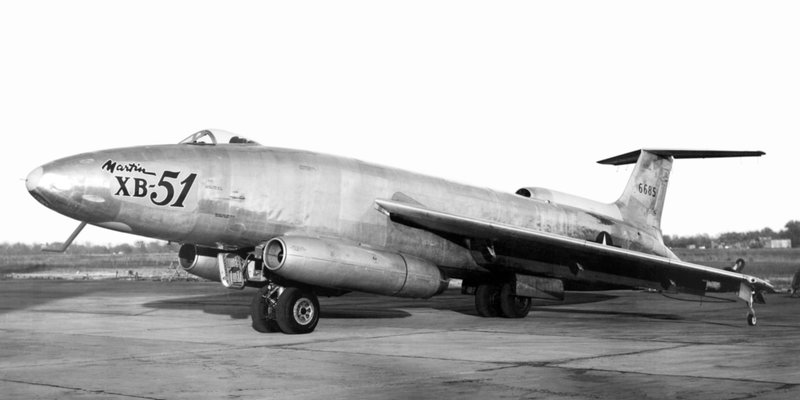
The XB-51 did not have bombing radar, with targeting provided by a Short-Range Air Navigation (SHORAN) system. There was a forward-looking film camera in the nose, plus a vertical camera and rear-facing camera in the belly.
___________________________________________________________________
MARTIN XB-51:
___________________________________________________________________
wingspan:
16.18 meters (53 feet 1 inch)
wing area:
50.9 sq_meters (548 sq_feet)
length:
25.93 meters (85 feet 1 inch)
height:
5.28 meters (17 feet 4 inches)
empty weight:
14,020 kilograms (30,905 pounds)
operating weight:
26,250 kilograms (57,875 pounds)
max take-off weight:
28,330 kilograms (62,450 pounds)
max speed at altitude:
1,035 KPH (645 MPH / 560 KT)
service ceiling:
12,730 meters (41,750 feet)
operational range:
1,730 kilometers (1,075 MI / 935 NMI)
ferry range:
2,325 kilometers (1,445 MI / 1,255 NMI)
___________________________________________________________________
There were two crew, including a pilot in a small bubble canopy, and a navigator sitting behind him in the fuselage; both had upward-firing ejection seats. The canopy could be jettisoned for ejection but did not open, with access to the cockpit via a hatch on the belly between the engine intakes.
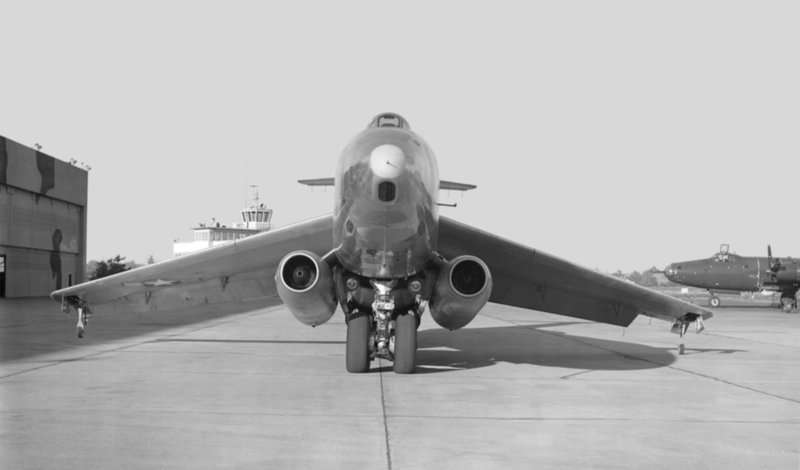
Test flights showed the machine to have few "funnies", and it proved very maneuverable. In 1950, the USAF began a competition to find a replacement for the Douglas A-26 / B-26 Invader, with the XB-51 ending up competing with the British English Electric Canberra. The stodgier Canberra was judged the better aircraft, in particular having substantially greater endurance.
The Air Force ordered an initial batch of "B-57" machines, to be built under license by Martin; they had substantial changes from the British-built Canberra, most notably adding the rotating bomb bay from the XB-51. There was consideration of obtaining the B-51 for the daylight bombing and reconnaissance roles, but that requirement was won by the Douglas B-66 Destroyer. The two XB-51s remained in test and trials use, the first prototype being lost in a fatal crash in 1952, the second being lost in a take-off crash in 1956.
BACK_TO_TOP* Sources include:
Some information was also obtained from web writings by aviation enthusiast Joe Baugher.
* Illustrations credits:
* Revision history:
v1.0.0 / 01 may 23 v1.0.1 / 01 jul 23 / Added details. v1.0.2 / 01 jul 25 / Review & polish. (*)BACK_TO_TOP
